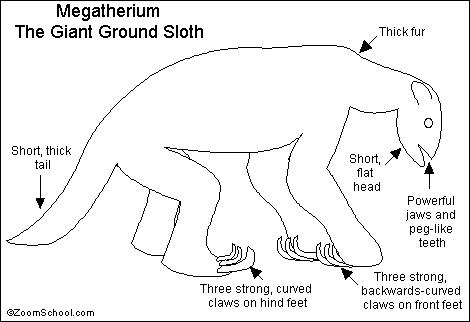
 |
| You might also like: | Animal Coloring pages: Me-Mi | Animal Coloring pages: Ma | Today's featured page: Butterfly and Caterpillar Crafts |
| EnchantedLearning.com More Mammal Printouts | EnchantedLearning.com Giant Ground Sloth | Animal Printouts Label Me! Printouts |


(pronounced MEG-ah-THEER-ee-um) Megatherium was a huge, bulky, slow-moving mammal that lived during the Pleistocene epoch in South America. It went extinct about 11,000 years ago. This ice-age mammal was the largest of the ground sloths; Megatherium's name means "great beast." Megatherium was named by paleontologist Richard Owen in 1856; the first Megatherium fossil was found in Brazil in 1789.
Anatomy: Megatherium had peg-like teeth, powerful jaws, and a thick, short tail. It had three hook-like claws on each foot. It was primarily a quadruped (walked on four legs). Megatherium was about the size of an elephant. It was roughly 20 feet (6 m) long and weighed about 3-4 tons.
Behavior: Megatherium was an herbivore (a plant-eater). It ate leaves, shoots, roots, and fruit. It may have eaten leaves from the tops of trees while standing upright on its hind legs, using its tail to balance.
| Search the Enchanted Learning website for: |